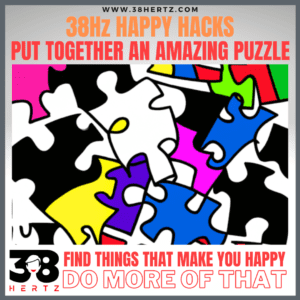
The happiness derived from putting puzzles together is a universal and timeless joy that transcends age and background. From the moment we pick up the first puzzle piece to the triumphant placement of the last, this activity takes us on a fulfilling journey of patience, problem-solving, and pure satisfaction.
What truly makes the experience of puzzle-solving so enjoyable is the sense of accomplishment that follows each successful connection. As each piece falls into place, it’s like a mini-victory, rewarding us with an immediate boost in self-esteem and confidence. The intrinsic reward system within our brains is triggered, releasing a surge of dopamine, the “feel-good” neurotransmitter. It’s true, puzzle making literally makes us happy! The act of putting puzzles together is not merely a pastime; it’s a portal to happiness. It encourages mental agility, mindfulness, and relaxation. It offers a tangible sense of accomplishment and a shared connection with others. In a world filled with complexities, puzzles remind us that sometimes, happiness can be found in the simplest pieces coming together to form a beautiful and complete picture. Ah, I love that!
Puzzle Tips
- Sort Your Pieces: Begin by sorting your puzzle pieces. Separate the edge pieces from the interior ones. You can also group pieces with similar colors, patterns, or edge shapes.
- Start with the Edges: Assemble the edge pieces first. These pieces are your puzzle’s frame, providing a clear boundary for the image. It’s a great way to establish the puzzle’s borders.
- Focus on Colors and Patterns: Look for distinctive colors or patterns on the pieces that can guide your connections. If the puzzle features a specific object or scene, focus on finding those unique elements.
- Build in Sections: Rather than attempting to complete the puzzle as a whole, consider building it in sections. Concentrate on smaller areas, such as a specific object or a corner, and then connect these sections to form the larger picture.
- Use the Picture: Keep the image on the puzzle box or a reference picture nearby. It can help you visualize the finished product and serve as a handy guide.
- Try Different Perspectives: Sometimes, rotating a piece or looking at it from different angles can help you see where it fits. Don’t be afraid to experiment with different orientations.
- Be Patient: Puzzle-solving is all about patience. Don’t get discouraged if it takes time to find the right piece. Take breaks if needed and return to it with fresh eyes.
- Work in Good Lighting: Adequate lighting is crucial to see the details and colors of each piece clearly. Natural daylight or a well-lit room is ideal.
- Organize Your Workspace: Keep your work area clean and organized. A clutter-free environment makes it easier to find and place pieces.
- Collaborate: Solving a puzzle with friends or family can be a fun group activity. Each person can focus on different parts of the puzzle, making it a team effort.
- Check and Double-Check: As you place pieces, double-check their fit with adjacent pieces. Ensure that the shapes and patterns align correctly.
- Celebrate Small Victories: Celebrate each time you find and place a piece. These mini-successes can keep you motivated.
- Use Puzzle Accessories: Some puzzles come with accessory pieces, such as edge connectors or reference pieces, which can aid in solving.
- Consider the Difficulty: Choose a puzzle that matches your skill level. Beginners should start with simpler images, while more experienced puzzlers can tackle complex designs.
- Frame Your Completed Puzzle: Once you finish your puzzle, consider framing it as a keepsake or wall art.
Pick out an amazing puzzle – (yes, I actually used the keywords “amazing puzzle”)
Try out a puzzle table (and let me know how you like it).


